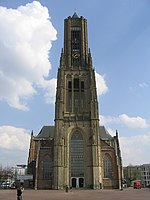Battle of Arnhem (1813)

The Battle of Arnhem (30 November 1813) saw Friedrich Wilhelm Freiherr von Bülow's Prussian corps fight an Imperial French division under Henri François Marie Charpentier at Arnhem. Attacking under the cover of fog, the Prussians broke into the city at several points and forced the French to retreat to Nijmegen after hard fighting in this War of the Sixth Coalition clash. Arnhem is a city in the Netherlands located on the Rhine River 100 kilometres (62 mi) southeast of Amsterdam. In late November 1813, Bülow's III Prussian Corps invaded the Netherlands, sparking a Dutch rebellion against the French. Marshal Jacques MacDonald commanding the defending French XI Corps ordered Charpentier to evacuate Arnhem, but that general chose to ignore his instructions and suffered a defeat. After winning the battle, Bülow continued west in order to liberate Utrecht and support the Dutch revolt. The Prussian general's forces were soon joined by a British expedition led by Thomas Graham, 1st Baron Lynedoch. Nevertheless, friction between the Prussians and their Russian and Swedish allies resulted in a pause in the effort to liberate Holland and Belgium from the French.
Excerpt from the Wikipedia article Battle of Arnhem (1813) (License: CC BY-SA 3.0, Authors, Images).Battle of Arnhem (1813)
1e Wijkstraat, Arnhem
Geographical coordinates (GPS) Address Nearby Places Show on map
Geographical coordinates (GPS)
| Latitude | Longitude |
|---|---|
| N 51.983333333333 ° | E 5.9166666666667 ° |
Address
1e Wijkstraat 2
6828 EA Arnhem
Gelderland, Netherlands
Open on Google Maps










